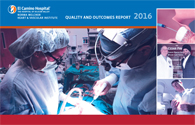Advanced Care and Diagnostics
At the Norma Melchor Heart & Vascular Institute at El Camino Health, our heart and vascular specialists use a wide range of nonsurgical techniques to diagnose your condition. Your doctor can also use these advanced tools to plan or guide minimally invasive procedures or determine how you’re responding to treatment.
We’re committed to your safety and comfort, so we adhere to the highest patient-care standards.
Echocardiography and Ultrasound Imaging
El Camino Health’s advanced echocardiography lab offers some of the latest imaging technology available to provide you with exceptional care. Our attention to quality care has earned accreditation by the Intersocietal Accreditation Commission.
Our cardiovascular specialists use a variety of ultrasound exams, which use sound waves to create moving and still pictures of your heart and vascular system — without exposing you to radiation. To perform an ultrasound exam, a sonographer slides a special probe on your skin over the area being examined, and the sound waves create images on a computer screen.
Ultrasound exams include:
- Echocardiogram. An echocardiogram allows your doctor to assess the structure and functioning of your heart. In some instances, your doctor may use a transesophageal echocardiogram to get a clearer picture of your heart. The exam uses a special probe that’s guided down your throat and positioned close to your heart to visualize its functioning.
- Carotid ultrasound. When your carotid arteries (located on either side of your neck) are narrowed by plaque, called carotid artery disease, it can lead to stroke. Your doctor can use this exam to see the structure of your carotid arteries, evaluate blood flow and determine whether plaque has narrowed them.
- Intracardiac echocardiogram. In some cases, your doctor may use this minimally invasive procedure to get a clearer picture of your heart’s internal functioning. To perform the exam, your doctor inserts a small ultrasound probe into a vessel in your upper thigh that’s threaded into your heart to capture images of your heart.
- Vascular ultrasound. Your doctor can use vascular ultrasound to examine your arteries and veins for blockages, or test the integrity of arteries and veins before a vascular procedure.
Coronary and Peripheral Computed Tomography Angiography
Computed tomography angiography, or CT angiography, is a painless test that can identify blocked or narrowed coronary arteries. CT angiograms combine X-ray and computer technology to provide your doctor with a highly detailed, 3-D visualization of blood flow. In some cases, your doctor may use a contrast solution — that you either swallow or have injected — to make vessels and tissues more visible.
A CT angiogram can help your doctor determine if you need treatment to unblock arteries, such as angioplasty, stent placement or surgery. Doctors perform CT angiography to scan arteries in your heart and peripheral CT angiography to scan arteries that supply blood to your limbs and organs.
HeartFlow® Analysis
If your cardiologist has conducted a CT scan of your heart but still needs more information about the blockages in your arteries, he or she may recommend you undergo a HeartFlow® analysis. HeartFlow is a noninvasive heart test which uses a CT scan to generate a personalized digital 3D model of your heart. Using highly sophisticated technology and computer algorithms, HeartFlow technology calculates how much each blockage is limiting your blood flow. Armed with this information, your cardiologist can make an informed decision about the best next step in your treatment plan.
Electrophysiology Exams
To diagnose arrhythmias and other heart conditions, our specialists rely on El Camino Health’s advanced electrophysiology lab to assess your condition and develop a customized treatment plan. Our arrhythmia specialists use a variety of noninvasive and minimally invasive diagnostic exams:
- Electrocardiogram (EKG). An EKG is the most commonly used test to diagnose arrhythmias. This noninvasive, painless test uses electrodes (small stickers) placed on your chest to detect and record your heart's electrical activity. It helps your doctor assess your heartbeat, rhythm, and the strength and timing of electrical signals as they pass through your heart.
- Holter and event monitors. An EKG can only record your heart's electrical activity during the test, but Holter and event monitors can record irregularities after you leave the doctor’s office. These devices can record your heart's activity for 24 or 48 hours, allowing your doctor to examine irregular electrical activity when it occurs. You wear the monitor as you go about your daily activities, and the monitor transmits data to your doctor for analysis.
Magnetic Resonance Angiography (MRA)
This type of MRI exam examines your heart's structure and blood flow and identifies damaged areas of your heart or blood vessels. MRI technology uses radio waves, magnets and a computer to create highly detailed still and live pictures of organs and tissues, without exposing you to radiation. This procedure may be performed with a contrast dye to provide more detailed pictures of your vessels.
Your doctor can use this exam to diagnose heart disease, valve disorders, strokes and peripheral artery disease.
Nuclear Cardiography
A nuclear cardiography exam evaluates how much blood your heart pumps with each beat. To perform the procedure, your doctor injects a safe amount of radioactive substance, or tracer, into your bloodstream, which travels to your heart. The tracer is detected by a special camera that takes pictures at specific times during a heartbeat. This exam can also be performed as a stress test to allow your doctor to visualize your heart when it’s working hard.
Stress Testing
Some heart problems are easier to diagnose when your heart is working hard. A stress test allows your doctor to monitor your heart while you exercise. If you can’t exercise, you’ll be given medicine to raise your heart rate. Electrocardiogram and nuclear cardiography exams are often performed as stress tests.
